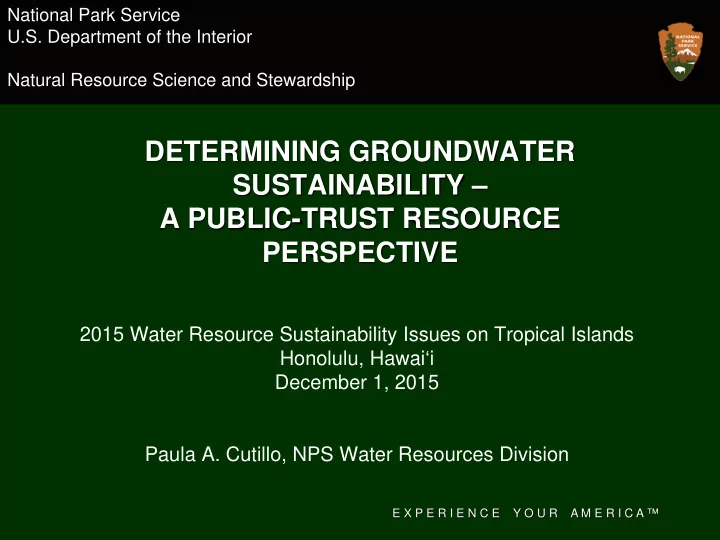

National Park Service U.S. Department of the Interior Natural Resource Science and Stewardship DETERMINING GROUNDWATER SUSTAINABILITY – A PUBLIC-TRUST RESOURCE PERSPECTIVE 2015 Water Resource Sustainability Issues on Tropical Islands Honolulu, Hawai‘i December 1, 2015 Paula A. Cutillo, NPS Water Resources Division E X P E R I E N C E Y O U R A M E R I C A ™
The Water Budget Myth The idea that the recharge is important in determining the magnitude of sustainable development is a myth. (Bredehoeft 2002) The source of water derived from wells (Theis 1940) • Safe yield (Lohman 1979) • The water budget myth (Bredehoeft et al. 1982) • Why “safe yield” is not sustainable (Sophocleous 1997) • Safe yield and the water budget myth (Bredehoeft 1997) • Sustainability of ground-water resources (Alley et al. 1999) • The water budget myth revisited (Bredehoeft 2002) •
Source of Water Derived from Wells All water discharged by wells is balanced by a loss of water somewhere. (Theis 1940) Where are the losses? Are they acceptable?
Impacts of Groundwater Withdrawals (Curruth 2003)
Pre-Development (Barlow & Leake 2012)
Removal of Water from Storage (Barlow & Leake 2012) lowered water levels rising saltwater
Captured Groundwater Discharge (Barlow & Leake 2012) streamflow depletion less freshwater discharge saltwater intrusion
Factors That Affect Capture Aquifer properties Distance between wells and boundaries Pumping rate Recharge *Location, location, location
Submarine Groundwater Discharge Image courtesy Craig Glenn/University of Hawai‘i SOEST
‘ Aimakapā Fishpond
What Is Groundwater Sustainability? The State’s first definition of sustainability : Respects the culture of communities Balances economic, community, and environmental priorities Meets needs of the present without compromising the ability of future generations to meet their own needs
Sustainable Yield “ Sustainable yield ” means the maximum rate at which water may be withdrawn from a water source without impairing the utility or quality of the water source as determined by the commission. STATE WATER CODE Chapter 174C of the Hawai‘i Revised Statutes
Saltwater Intrusion KAHALU‘U SHAFT Pumpage (million gallons per day) Chloride (milligrams per liter) http://hi.water.usgs.gov/recent/westhawaii/chloride.html Keauhou Aquifer System Sustainable Yield = 38 million gallons per day Kahalu‘u Shaft Pumpage = 4 million gallons per day
Declining Water Levels Instantaneous Water Level at Hualalai Deepwell (feet above mean sea level) Water level (Commission on Water Resource Management 2014) Keauhou Aquifer System Sustainable Yield = 38 million gallons per day Keauhou Aquifer System pumpage = 15 million gallons per day Hualalai Deepwell Pumpage = 0.84 million gallons per day
1980 Robust Analytical Model (RAM) Freshwater-lens system Recharge & wells evenly distributed Sharp interface Freshwater Lens Saltwater
1980 Robust Analytical Model (RAM) Freshwater-lens system Recharge & wells evenly distributed Sharp interface Freshwater Lens Saltwater In view of the above limitations, the sustainable yield estimates should be used as a guide in planning rather than an inflexible constraint. (1990 Water Resources Protection Plan)
Public Trust Resources If the RAM-calculated sustainable yield cannot prevent saltwater intrusion in a coastal well, how well will it protect public trust resources?
Capture Zone Delineation (Whittier et al. 2010)
Capture Zone Delineation (Preliminary) (Data courtesy Robert Whittier/State of Hawai‘i Department of Health)
1999 USGS Numerical Model (Modified from Oki et al. 1999) Capture = 3 million gallons per day in park (Oki et al. 1999)
Summary Capture a function of well location (not recharge) Numerical models can estimate where capture occurs Sustainability guided by estimates of capture Where will capture occur? How much is acceptable for public trust resources? (Curruth 2003)
Acknowledgements University of HI USGS Craig Glenn Delwyn Oki Joe Fackrell Scot Izuka Jacque Kelly David Foote Lori Tango Eric Grossman
Water Resources Division Natural Resource Science and Stewardship http://www.nature.nps.gov/water/index.cfm National Park Service U.S. Department of the Interior
More recommend